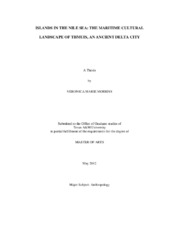| dc.description.abstract | In ancient Egypt, the Nile was both a lifeline and a highway. In addition to its crucial role for agriculture and water resources, the river united an area nearly five hundred miles in length. It was an avenue for asserting imperial authority over the vast expanse of the Nile valley River transport along the inland waterways was also an integral aspect of daily life and was employed by virtually every class of society; the king and his officials had ships for commuting, as did the landowner for shipping grain, and the 'marsh men' who lived in the northernmost regions of the Nile Delta. Considering the role of water transport in ancient Egypt we know surprisingly little about the maritime environment along the inland waterways of the Nile Delta. The physical interface between man and river is frequently obscured by the dearth of evidence for Delta waterways and fluvial harbors, and a lack of awareness for ancient hydrological conditions.
This thesis provides a preliminary reconstruction of the maritime cultural landscape of one Egyptian city, Thmuis, located in Egypt's eastern Nile Delta during the Hellenistic and Roman periods. It will demonstrate how the inhabitants of Greco-Roman Thmuis perceived, utilized, and interacted with their maritime environment, by incorporating available archaeological, material, geological, and textual evidence from Tell el- Timai (Thmuis).
These sources indicate that the Egyptians developed numerous ways to harness the dynamic riverine landscape of the eastern Nile Delta. Methods of irrigation were employed to divert and control the fruitful waters of the flood. Canalization enhanced the connectivity of the Nile Delta when the primary branches of the river were not suitable for sailing. Harbors were specially adapted to the shifting riverine conditions. When physical effort would not suffice, gods and goddesses were invoked to assist in the perils associated with life along the Nile, but also to ensure favorable conditions for navigating the inland waterways and the seas. After three thousand years of interaction with the Nilotic landscape, the Delta people developed a rich and complex relationship with their riverine environment that is evident in the Mendesian ideology, infrastructure, and history. | en |


